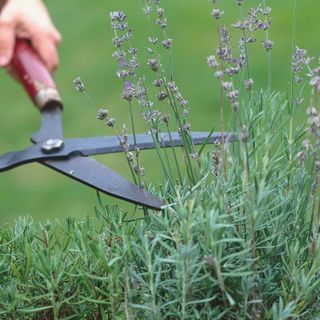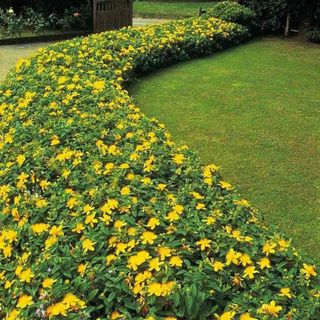How to trim ground cover plants – 5 tips to keep your garden border tidy
Keep these helpful garden features in check


Ground cover plants are unsung heroes of the garden. They form an attractive carpet, opening the floor to various garden border ideas, while protecting the soil from erosion.
It's easy for them to grow beyond their allotted space, though, which is why it's important to know how to trim ground cover plants.
These plants add year-round interest to the garden while providing a host of benefits. For example, ground cover plants can suppress weeds and even retain soil moisture by acting as a makeshift mulch. They're a real helper and time-saver in the garden.
We've asked the experts for their best tricks for cutting back ground cover plants to help you keep your space in check.
How to trim ground cover plants
Ground cover plants are often overlooked when deciding what to prune in June. Left alone, they can grow well beyond the space you initially planned for them.
Ground cover plants come in various types, including flowering and non-flowering varieties. They're often evergreen, like ivy, meaning they'll stick around all year. Plus, there are lots of ways you can use ivy in the garden, among other evergreen plants.
Exactly how to trim ground cover plants will depend on each variety, but we're covering the simple tricks you can apply to most types.
Get the Ideal Home Newsletter
Sign up to our newsletter for style and decor inspiration, house makeovers, project advice and more.

Morris Hankinson is the Founder and Managing Director of Hopes Grove Nurseries Ltd, the UK’s only specialist grower-retailer of hedging plants. After graduating with a Commercial Horticulture Degree from Writtle College, Essex in 1992 Morris established the nursery the same year on a half-acre plot at the 25-acre family farm in Tenterden, Kent. The business soon grew to cover the whole farm and now grows hedging plants across three nursery sites in the beautiful Weald of Kent totaling 130 acres, employing 20 full-time local staff, and serving over 17000 customers each year.

What you'll need
1. Setting up
- A pair of high-quality bypass secateurs ARS Professional Bypass Secateurs from Amazon
- Gardening gloves
- Rake
- Bag to collect clippings
Ensuring you have the right equipment for trimming plants in the garden will save both time and pitfalls later on.
‘Make sure you have the right tools, including pruning shears or scissors, gloves, and a rake,' says Morris.
'Ensure the tools are clean and sharp to make precise cuts and avoid damaging the plants.’
Knowing how to clean your tools between trimming sessions will ensure that diseases aren't spread between plants.
You can even use larger equipment like a heavy-duty lawn mower with the right settings – but more on that later.

2. Remove diseased growth
Check the plants over for any damaged growth. Ground cover plants grow close together, meaning diseases can easily spread between plants.
Diseases to look out for include blight and fungal leaf spots, which thrive in conditions that lack air circulation. Ivy is particularly susceptible to fungal leaf spots, and rust is one of several common rose problems and diseases.
It’s important to remove diseased growth to prevent infections from spreading to other areas of the ground cover.

3. Get trimming
Next, focus on reducing the size of the ground cover.
‘Cut back any overgrown or leggy stems to promote a more compact and bushy growth habit,’ advises Morris. ‘Trim back about one-third of the plant’s height. This will stimulate new growth from the base and prevent the plant from becoming too woody.’
Petar Ivanov, garden expert at Fantastic Gardeners, recommends several different tools for trimming ground cover plants: ‘I’d recommend using a string line trimmer and cutting the leaves back to 5 to 8 centimetres above ground level.’
‘Alternatively, you can use a heavy-duty lawn mower if you have one, which you can even get inside the garden bed or border with. With this trimming method, you’ll first need to make sure your mower’s blades are well-sharpened and set them between 5 to 8 centimetres in height.’
‘Mow over the top of your round cover plant and, if you can, go over the area twice in opposite directions for cleaner and more even results.’

Petar Ivanov is a gardening and plant expert who has been working at Fantastic Gardeners for 8 years. As one of the company's top-performing experts, he now manages over 6 teams of gardeners, delivering stunning landscape results and fostering a deep connection with nature through his work. With his green thumb, leadership skills, commitment to sustainability and determination to learn, Petar's wish is to leave a lasting mark in the world of gardening.
4. Tidy up old growth
As you trim your ground cover plants, make sure you cut away any dead or old growth to allow light and air to reach the new shoot.
'This helps prevent mould and encourages healthier plants,' advises Morris.
For ground cover plants in a small area, Petar advises using hand or shrub shears to prevent damage to surrounding plants. ‘Even though it’ll take you longer to perform the task with these tools, you’ll be more accurate and will prevent damage to any other specimens.’

5. Aftercare
Your ground cover plants will need some TLC after they've been trimmed.
'After trimming, water the plants well to help them recover from the stress of pruning,' Morris suggests.
'Then, add a layer of mulch around the plants to retain moisture and suppress weeds.'
What to avoid
While it’s tempting to dive straight into the task of trimming your ground cover plants, there are a few reasons to hold back until the conditions are right.
‘Avoid trimming during extremely hot or dry periods to prevent stress on the plants,’ says Morris.
‘Spring and early summer are usually the best time to trim ground cover plants, as that is when they are actively growing.’
What to trim

Achilleas respond well to cutting down after flowering, encouraging fresh growth and sometimes a late flush of flowers.
FAQs
Do you have to trim ground cover plants?
Most experts agree that it is necessary to trim ground cover plants to keep them in check as they grow. However, there are ways you can lengthen the time between trims.
'If there’s no physical barrier around your ground cover, then it's likely that it will advance outwards beyond the original planting area,' says John Clifford, director of Gardenstone. 'To keep your ground cover under control, you'll have to trim it regularly to prevent the spread of underground stems.
'However, you can avoid trimming by installing edging around your ground cover. I recommend edging in the form of a wooden, metal, brick or plastic barrier that is placed in the ground surrounding the planting area, as this will prevent them from growing out of control.
'With effective edging in place you will only be required to trim the unhealthy or dead parts of the ground cover'.

John Clifford is a director of Gardenstone, a leading garden landscaping retailer based in the UK. With over 30 years in the gardening industry and continual work alongside The National Trust, John has amassed an extensive range of gardening and planting knowledge. Alongside his younger son, John has built a strong reputation for Gardenstone as a trusted source for both high-quality garden products and expert gardening advice.
How do you look after ground cover plants?
In addition to some basic trimming and pruning, ground cover plants will need to also be fertilised afterwards when the weather starts to warm up, typically in March.,' says Petar Ivanov.
'Do that by using a three-month or longer slow-release fertiliser. Besides purchasing it, you can also make natural fertiliser yourself from organic matter, coated urea or polymer-coated formulas.'
Keep your garden looking tidy and start trimming this weekend.

Sophie joined the Ideal Home team as Gardens Editor in June 2024. After studying English at Royal Holloway, University of London, she began writing for Grow Your Own, which spurred on her love of gardening. She's tried growing almost every vegetable under the sun, and has a soft spot for roses and dinnerplate dahlias.
As Gardens Editor, Sophie's always on the lookout for the latest garden trend. She loves sharing growing hacks for every space, from herbaceous borders to balconies.
-
 It’s normally impossible to find a Dyson vacuum for under £250 — but QVC has slashed the price of their bestselling models for a limited time
It’s normally impossible to find a Dyson vacuum for under £250 — but QVC has slashed the price of their bestselling models for a limited timeRun don’t walk to pick up the brand’s bestselling model for under £230 before it sells out
By Lauren Bradbury
-
 How to remove algae from a fence — 4 methods that will banish the green and prevent wood rot
How to remove algae from a fence — 4 methods that will banish the green and prevent wood rotYou don’t have to replace a fence if it’s covered in algae. Here's what to do…
By Kayleigh Dray
-
 I wish I'd known about these 4 things before I bought my Le Creuset – here's how you can learn from my mistakes
I wish I'd known about these 4 things before I bought my Le Creuset – here's how you can learn from my mistakesHere's how to make sure your Le Creuset will still be your most-used pan in a decade
By Molly Cleary

